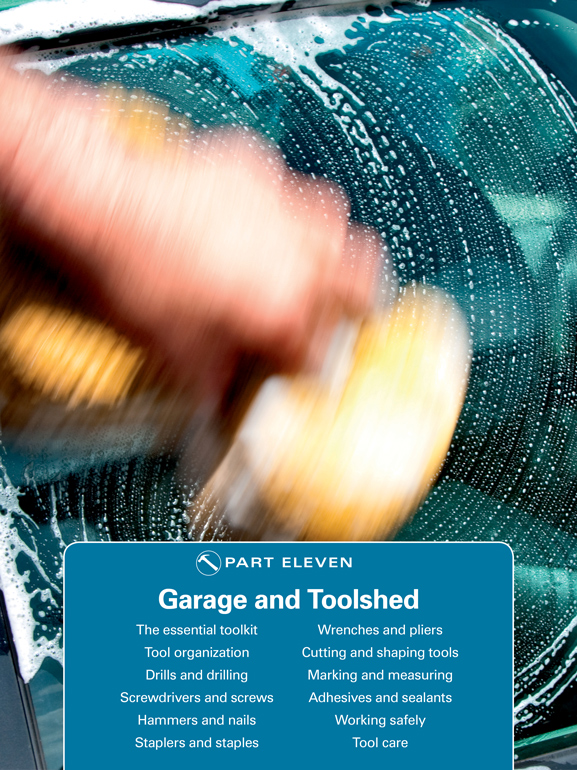


Nail scraps of carpet or pieces of an old tire to posts and other obstructions that the car— or its flung-open doors—might inadvertently crash into or scrape against.
No matter what its size, a well-planned garage will shelter your car and make it easy to do some regular maintenance, too.
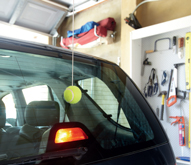
Save your car and the garage wall from damage by installing a simple parking guide. A tennis ball hanging from the ceiling will do the trick. First, run a length of string through the tennis ball. Next, park the car in the ideal position. Now, hang the string so that the tennis ball is just touching the center of the windshield.
Choosing and installing proper lighting in a garage is a must for completing tasks and preventing accidents.
Centering a car in a narrow garage to allow for adequate door room on both sides can be a challenge. One way to make the task easier is to use a strip of reflective tape as a guide. Cut the tape to match the width of your car and fix it to the back wall of the garage in the perfect position. Line your car up with the strip as you drive in and you'll have a perfectly centered parking job every time.
If you're doing fine detailing work on your car, you'll want good lighting. A couple of portable halogen or fluorescent floodlights, either on stands or hooked onto the rafters, are a good option.
For your safety you should be certain that your front and rear lights are always in good working order. Fix one mirror to one of the inside front corners of your garage and another to an inside back corner and set them so that you can see a pair of lights in each mirror. That way you can see at a glance whether your lights are working.
To check for engine problems, line the garage floor with newspaper and park the car on top. Later, when you drive the car out, check the newspaper for drips and stains. Dark greasy droplets could mean an oil leak. Clear oily stains could be caused by leaking brake fluid. Red drips could indicate a loss of transmission fluid. Greenish puddles are likely to be escaped coolant.
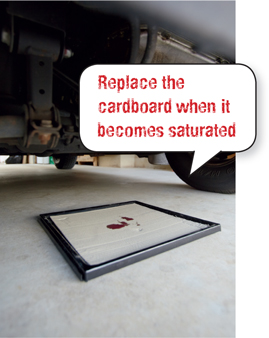
Until a leaking car can be fixed, protect the garage floor with a homemade drip pan. Lay a sheet of corrugated cardboard on a large baking tray and slide the tray under the site of the leak.
It only takes a few simple maintenance exercises to keep a garage door running smoothly, year-round for years to come.
To keep a manual roller-door from crashing down while you're working, wedge a stout piece of wood between the floor and the door's bottom corner, and then attach a C-clamp to the door track just in front of the top roller.
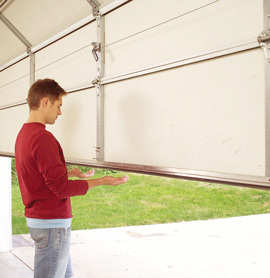
A garage door that isn't properly balanced will strain an automatic opener. Check the door regularly and you could avoid expensive repairs down the track. Close the door then disengage it from the automatic opener by pulling down on the emergency release handle. Manually open the door halfway and let go. A balanced door will stay in the halfway position or creep down slowly. An unbalanced door will close quickly or need some hard tugs to bring it down. If the door is out of balance, call a garage door professional to correct the spring tension.
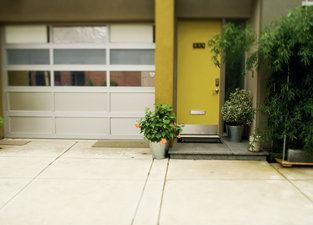
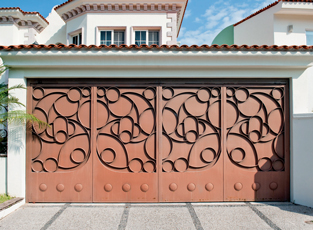
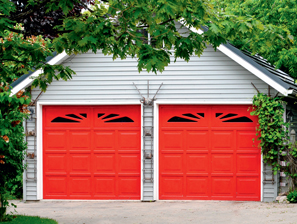
Toxic fumes can build up in a garage, whether from stored household chemicals and fertilizers, or from the exhaust vapors produced by cars and lawnmowers. For that reason, a garage must be well ventilated. Use weather stripping to keep out dust and debris, but stop short of making the garage an airtight space. And never run a car or mower in the garage unless the garage door is open.
More often than not, all a tricky garage door needs is a good cleaning and oiling of its moving parts.
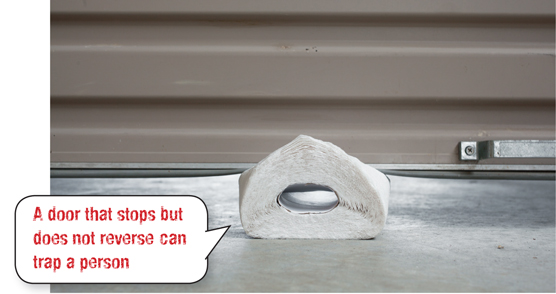
An automatic reversing function will trigger the garage door to retract when it comes into contact with an object (like a car or a misplaced bicycle). Check the function regularly by placing a roll of paper towels on the ground under the door. If the door doesn't retract when it hits the roll, call in a professional to service the mechanism.

Some garage doors have a spring directly above the door that acts as a counterbalance and determines how much effort it takes you to raise and lower the door. These springs, called torsion springs, have dangerously high tension and can cause serious injury. Call a professional to fix a faulty torsion spring.
Once or twice a year, switch your garage door into manual mode and open and close it slowly by hand. If there are any emerging problems—if the springs are losing their tension or the rollers aren't running smoothly in their tracks—you'll feel it then.
In order to burglar-proof your garage, go back to basics. Unplug the door opener and reactivate the manual lock. Also fit bolts with padlocks on the inside as an additional disincentive for thieves who enter through the house.

Metal doors can dent very easily. If the dents are shallow, try tapping them out with a wood block and hammer. If they're deeper, consider calling the manufacturer and having the whole panel replaced.

Fresh oil splashes can be soaked up by cat litter. Keep some handy in the garage and scatter it over spills when they occur. Leave the litter to sit overnight and by morning it will have soaked up the oil and the floor will be stain-free.
Even the smallest of garages can serve as both storeroom and workspace, as long as it's well looked after.
An unfinished concrete floor is a porous surface and any ignored oil spills will quickly turn into stains. Sealing the floor provides a permanent solution. First, sweep the floor, and then seal it with a paintable concrete sealer. To finish, apply one or two coats of garage floor paint (non-slip if possible). The heavy-duty gloss paint is impervious to liquids so you'll always be able to wipe up drips and spills.
A sealed concrete floor in the garage generally requires minimal maintenance. An annual wash down and a new coat of sealer should do the job. If you're painting the floor, use an acrylic paint rather than an oil-based masonry paint.
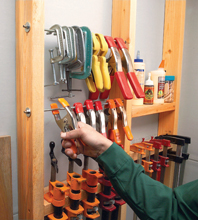
If you have open studs in your shed or garage, make the most of them. To keep clamps sorted, drill holes in the studs and install lengths of threaded steel rod, tensioned with washers and nuts. Screw shelf brackets to the studs and then install as many shelves as you need. You can cut the shelves from scraps of wood.
Organize the garage so that all the key items such as lawnmowers and bicycles fit neatly and easily. Then grab a can of bright yellow spray paint and mark out the “parking spaces” for each item. The outlines will remind you—and the rest of the household—where everything goes.
An old hammock strung over the car in a garage bay can be a clever storage place for sports balls, empty bags and other bulky lightweight items. Attach the hammock with stout screw eyes that are secured to the joists.
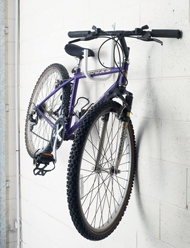
Store a lightweight bike off the garage floor with a couple of screw hooks attached to studs or joists. This is especially important if the bike is not in regular use. Tires eventually deflate and will rapidly deteriorate if a bicycle is left standing in one spot for too long.
The garage can be a good spot for a washing machine, but the little odds and ends that come loose during washing can be lost and forgotten in the large, often dimly lit room. Buy a magnetic key box (available from car accessory suppliers and some variety stores) and stick it on the washing machine. It can be used to store loose buttons and lost coins.
Many hand tools and even some lightweight power tools and pieces of gardening equipment can be attached to the wall using broad strips of hook-and-loop Velcro. Fix a long length of the hook side to the wall and shorter lengths of the loop side to each of the items you wish to hang. The gripping power of the Velcro will ensure that the items attach securely to the wall for storage. Remember that the hook side is the catching side: if you mistakenly fix that to your hand tool you'll find it sticks to everything from rags to your own clothes.
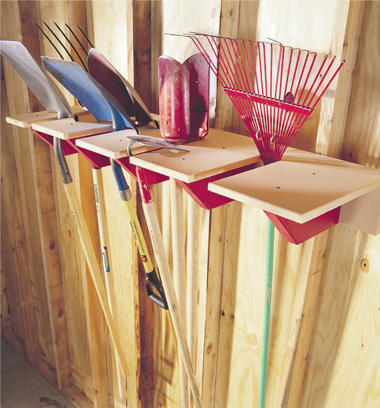
One clever way to maintain order in your garage is to group the clutter into activity-specific zones. Organize a section for gardening tools and products, another for sports gear, another for car maintenance tools and so on. You'll find it easier to locate an item when you need it.
Do not allow a garage to become a dumping ground-tidy things up immediately.
If there is no extra room anywhere for a workshop, install a fold-down workbench in the garage. The bench top can be made from a plain-surface solid-core door. Fasten it to the wall with a piano hinge about 35 in. (90 cm) above the floor. For legs, attach 2 x 4 in. (5 x 10 cm) lengths of wood to the outside corners with door hinges and tuck them underneath the bench when it folds down.

Try to keep the space surrounding entrances clear of stored items. If you have things like ladders or brooms stored right alongside a door, you'll often knock them over.
Whether your workspace is a stand-alone room or just a corner of the garage, the same rules apply: keep it tidy, and keep it safe.
If the electrical outlets around your workbench become clogged with sawdust, they can pose a fire hazard. A simple solution is to purchase some plastic childproof outlet covers and use them to plug up the outlets whenever they're not in use.
A workbench is easier and safer to use if all the power cords are hooked up and out of the way. For a hanger that lets a cord slide through without chafing it, cut a short length of old garden hose, slit it diagonally and tack it to the wall. Open the slit to insert or remove your cord as necessary. If you want to hold the cord in a fixed position, screw or glue some clothes pegs to overhead joists (or some other strategic positions) and drape the cord over them.
Keep work surfaces clean and clear and ready for work-use shelves and other spaces for storage.
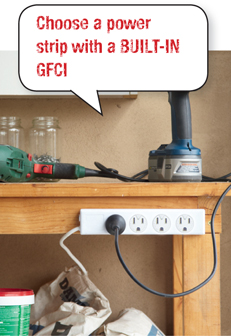
For easy access to electricity, hang a retractable (reel-type) extension cord from a hook screwed into an overhead joist. Or mount a multi-outlet power strip on the wall above your workbench or on a drop-down board bolted to a joist. Plug your new overhead power source into an existing outlet. If you have to run an extension cord to it, secure the cord loosely with slit-hose hangers (refer to previous tip). Permanently attaching an extension may violate electrical codes.
Give it a quick warm-up by installing an infra-red heat lamp over your workbench. It will warm your hands and tools so that you can work comfortably on cold days. Heat lamps typically draw 250 watts, so use sparingly and check that the wiring can handle the lamp plus whatever other equipment you use on that circuit.
Perforated hardboard, otherwise known as pegboard, is a simple and attractive way to hang up hand tools—but don't limit its use to workshop walls. Mount it on the inside of cabinet doors or on the sides of your workbench and cabinets and you'll substantially increase your storage potential.
Keep a bar magnet and a box of plastic sandwich bags on hand and you'll always be able to pick up spilled metal washers, nuts or nails with ease. Drop the magnet into the bag and run it across the area of the spill. The spilled items will stick to the magnet. When you've collected all the loose items, turn the bag inside out, remove the magnet and pour the contents of the bag into a container.
If you have a spare hair dryer lying around the house, give it a new home at your workbench. It can be used to blow away dust, dirt and shavings, to dry sweaty hands before handling new wood and to speed the drying of paint touch-ups.
Tack an old leather or strong canvas belt along the edge of a shelf to hold tools. As you nail it, leave small loops in the belt for tools to slip into.
Wrap tools in plastic wrap and lay on a board. Fix nails where they are to hang. Spray the tools and board with paint and leave to dry. Unwrap the tools, then hang them in the marked places.
Does the handle on a tool-laden drawer keep pulling off? Replace it with a garage door handle, or a similar item, secured with bolts going through the drawer front. Put flat and lock washers onto each bolt before screwing on the nut.
Standing on a concrete floor in front of your workbench for hours on end can strain your legs and give you a chill. Be good to yourself and lay a scrap of carpet down on the floor, or go all the way and install a rubber mat. The softer surface will be more soothing for your joints and will prevent heat loss between your feet and the cold concrete floor.